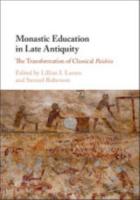
CUP (2018) h/b 399pp £90 (ISBN 9781107194953)
Christianity in late antiquity did not (pace Nixey and co.) seek to demolish classical culture—a glance at St Augustine or St Jerome soon refutes that idea—but it did see paideia as part of a continuous process of revelation which had reached its climax in the Christian message. Monasteries emerge (from the 4th century onwards) as vital actors in the relations between rulers and ruled and also in the transmission and determination of the culture which underpinned most of civilised life in both East and West. Monasteries were ‘powerhouses’ in more ways than one—powerhouses of prayer but also of culture—and this book does a superb job of looking at how their contribution was much more than merely being the passive or even iconoclastic transmitters of earlier culture. Monks shaped the future from their knowledge of the classical past.
There are still those who see the early monks as illiterate hermits (or worse)—men who eschewed all contact with the outside world and who would not know their Aristotle from their elbow—and Marrou loftily told us in 1956 that monastic schools taught their pupils to forget the poetry and secular knowledge they had. Evidence from the early monastic libraries dispels both notions at once and above all refutes the idea that Christianity was antithetical to classical paideia: as the editor of this book says pithily, ‘the transformation of Classical into Christian paideia is seen as a reformation rather than a revolution’ (p.4).
The cultural overlap is obvious in the continued use of terminology: Rubenson takes us through the words relating to ‘school’ and points out how education (the marker and the privilege of the better-off) required and utilised the four elements of leisure, tradition (involving the moral exemplarity of the teacher and where the novice learns how to be a monk by imitating his teachers), exercises of an educational type and organisation. Teaching also brought in much-needed cash to the monastery: which meant that an educated monk ‘would be a monk who could contribute financially’ (p.28). Teaching could take place in the church itself, as it did in Roman basilicas and later in Islamic mosques. Andreas Westergren follows this with a look at one author (Socrates Scholasticus, 380-c.439): here the image of (relatively uncultured) other-worldly ascetics is balanced by monastic practice at the busy court of the emperor Theodosius. Paideia was of course potentially dangerous: Julian (the emperor who renounced Christianity in favour of Hellenism) had been well educated and his conversion to paganism could be attributed to his association with Libanius and his teacher Maximus. It was vital that young people receive the right sort if they are to follow the Truth. Socrates makes it clear that not all Christians were learned and that there was need of a ‘totalising discourse’ which could speak to all levels of intellect, creating a climate in which a philosophy of words sits beside ‘a philosophy of deeds’ (p.70), learning and life. This was the ideal—a ‘fusion of Hellenic and Christian horizons, a preservation of Classical paideia combined with Christian faith’ (72).
The rest of the book explores and explain this with close reference to the evidence. Part II examines the elementary education provided: Roger Bagnall’s examination of monastic letters shows their authors and recipients to be educated men and women, while Larsen uses papyrological evidence to show the monastic education in action and combats the image of illiterate monks: we see the monks using classical models of education and simply swapping Psalms for Homer, biblical heroes for classical heroes (a practice to which Anastasia Maravela returns in the following chapter with the specific cases of Homer and Menander). Part III then looks at more advanced learning in monasteries in the cases of Didymus the Blind, Evagrius Ponticus and Rufus of Shotep. Didymus was no mere rote-learning catechist but could have functioned as a real grammaticus in the ancient world—albeit one who used biblical themes all the time, as did Evagrius: while Rufus’ homilies show a style which owes much to the rhetorical tradition of the past.
Part IV moves on to an area where the conflict between Christ and the classics could well turn nasty—philosophy. Chapter 10 shows how the image of the uneducated Christian as a ‘holy fool’ owes much to the Cynic and Epicurean schools, while the following chapter looks at the accommodation of Platonic ideas in the fifth century monastic writings of Theodoret and Marinus. Chapter 12 shows how the Sentences of Sextus make selective use of Pythagoreanism. In all three cases the wisdom of the ancients is being revalued in the light of Christianity and the new absorbs and modifies the old.
Monasteries were famous of course for copying and preserving texts from the classical world but Part V chooses to look at the manuscript tradition within the corpus of monastic writings themselves, showing how writers of ecclesiastical and historical texts revised and redrafted their own work. The final essay shows how a seminal text (the monastic apophthegmata) was made to travel to the Arabic-speaking world of Baghdad without losing the essence of what it wished to impart.
The book is lavishly produced and generously illustrated. All quotations from Latin, Greek, Coptic, Syriac and Arabic are translated and the level of copy-editing and proof-reading is high. It is also pleasing that the authors of these discrete chapters refer to each other regularly, allowing the volume to read as a team effort rather than a collection of monographs. Highly recommended.
John Godwin
